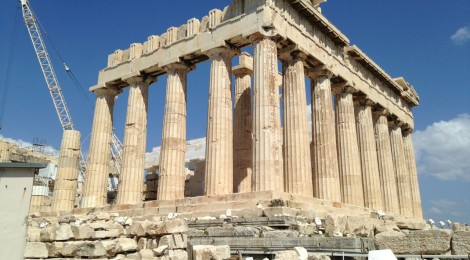
Still Standing and Still Delivering: Truths of the Acropolis
Even through a modern haze it is manifest almost from the moment you enter the Athens valley.
Acropolis.
Truth 1: You can’t help looking at the Acropolis. It draws the eye.
The first truth about this ancient place was no doubt true when the first people crossed into Attica: “Wow! Look at that mesa of rock right in the middle of this valley. It sure looks important.”
Truth 2: You want to climb the Acropolis. You want to be with it.
It probably took those ancient people another day to fulfill the second truth.
They had to walk over to the mesa and then find a way up: “Wow! Look at the amazing view from up here! You can see everything. It’s way more important than we first thought. Can we camp up here tonight?”
Truth 3: The Acropolis has emotional power. It invites awe.
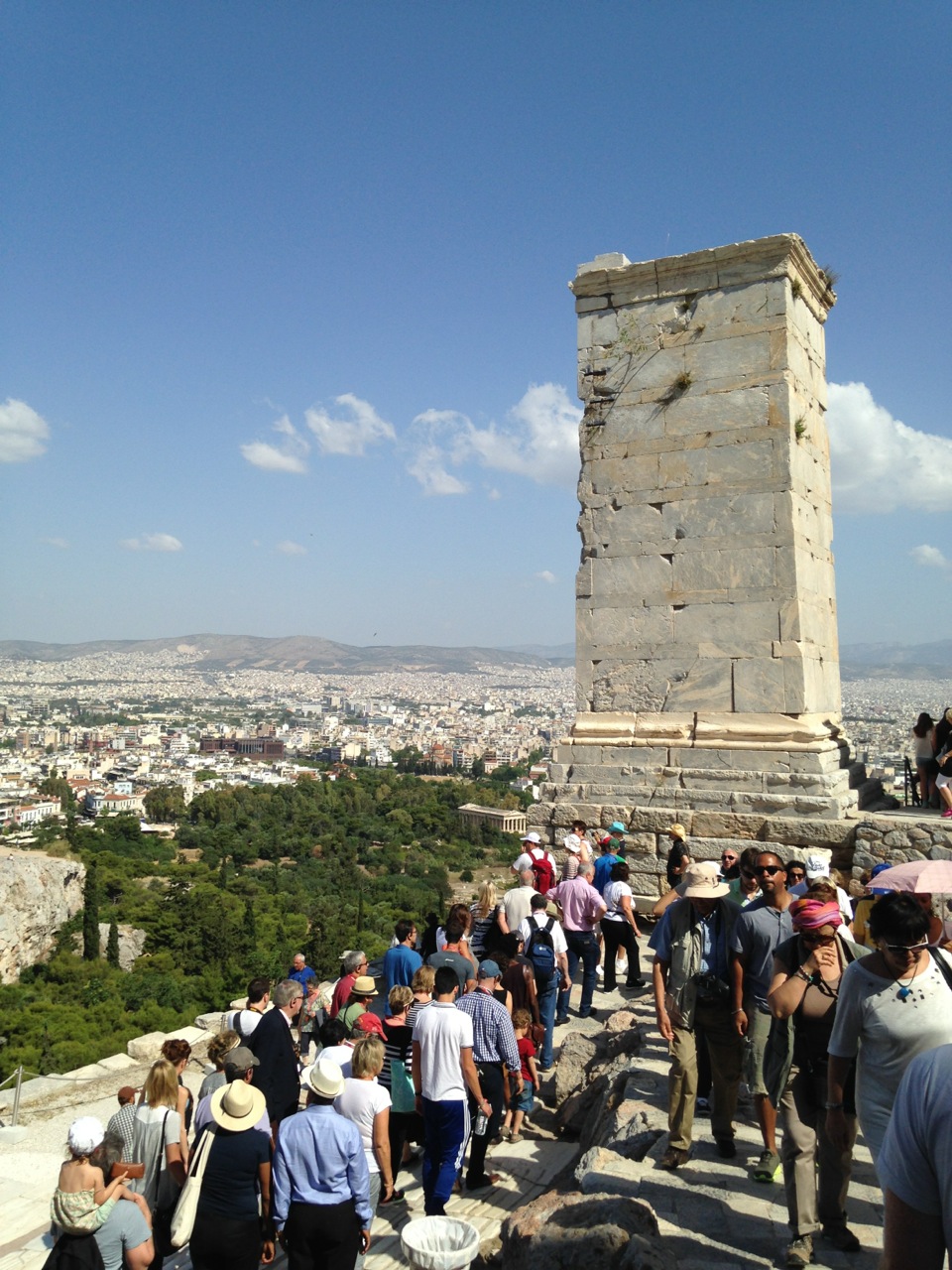
Climbing the Acropolis at the Monument of Markus Agrippa. Agrippa couldn’t make a personal appearance, but the scene gives a sense of the commanding view from the Acropolis. All of Attica is before you.
It takes absolutely no imagination to understand why people built temples, aspirational buildings, on top of this mesa. It is a place that feels closer to the inner essence of things than almost all others. Not doubt height and central location play a part in this. Mountaintops are powerful, of course, but there is something more to it at the Acropolis. The flat top inspires imagination. If Athena and Poseidon are already in your brain, you’d very naturally think this a spot for them to have it out, to vie for the favor of the people.
Truth 4: The Acropolis is many places at once. It is an architectural locus.
Because the Parthenon gets so much press, it’s easy to think that the Parthenon is the Acropolis.
At the top of the mesa we stand among ruins, plural: the Parthenon, the Temple of Athena Nike, the Propylaea, the Erechtheum. And they represent only the Pericles collection. The polis in Acropolis extends back over time, to a time before the Parthenon, if we can imagine it. And imagining the time before the Parthenon is important, because it helps us modern visitors like you and I and Alison see the Acropolis as the expression of highly evolved ideas that were tested and improved and reworked, not a single flash of pure genius. The brilliance that remains is a meeting of many minds over a long span of time.
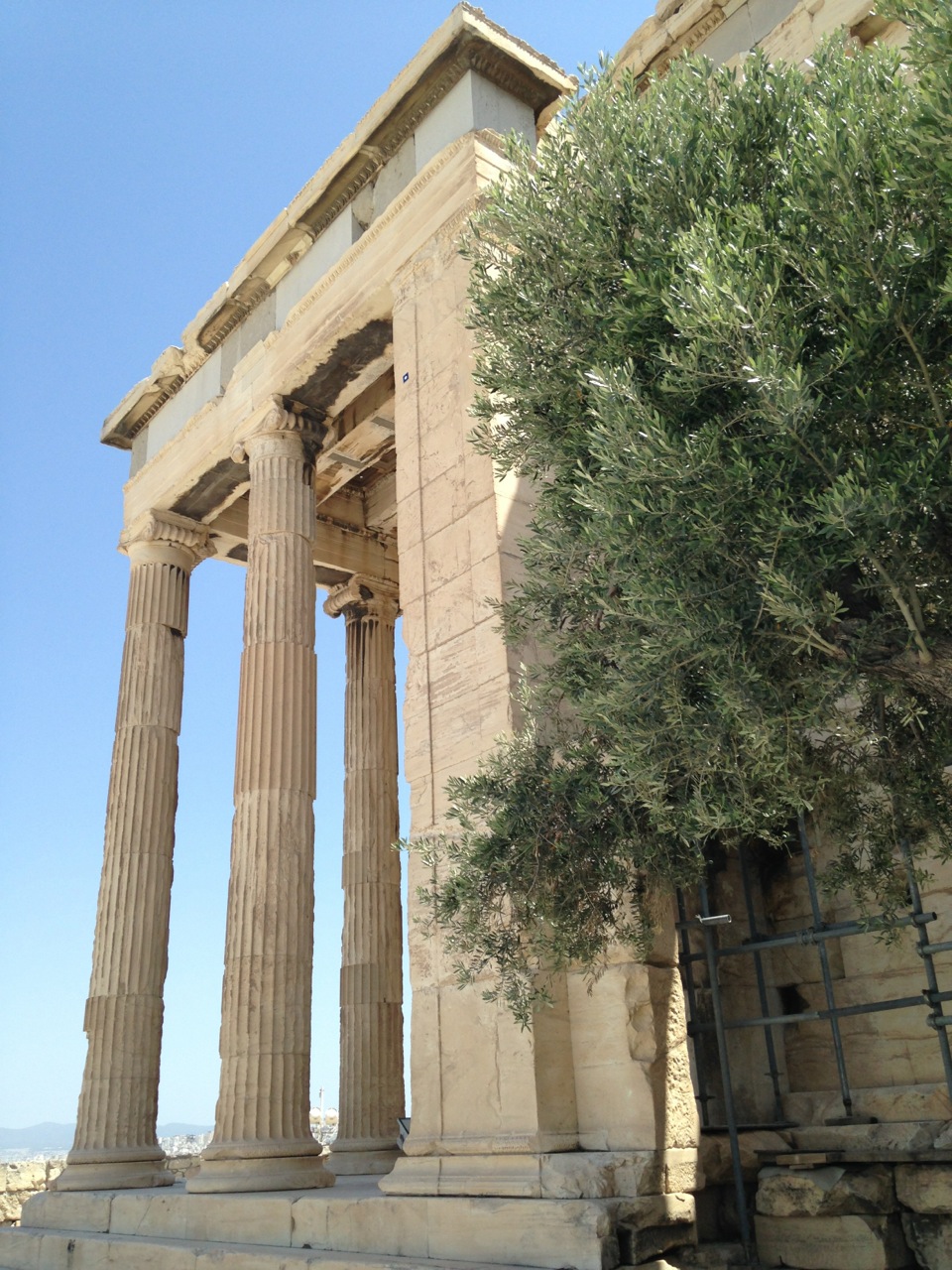
Looking northeast at the Erechtheum. The olive tree has ancient religious significance. It is on this spot that Athena was supposed to have given the world its first olive. Thanks Athena!
Truth 5: The Acropolis is a pinnacle of architecture. It remains a high water mark.
The Acropolis is staggeringly, gracefully beautiful. Even blasted apart, ravaged by time, surrounded by a completely different city, purposefully unmade by unbelievers, and partially surrounded by cranes and scaffolding it is staggeringly, gracefully beautiful. And I am not simply hand waving at the Parthenon. It is no wonder that western civilization copies it and copies it and copies it. Been to the Lincoln Memorial in Washington, DC? That’s the style of a Greek temple. Stood in awe at the Statue of Liberty? I have a sneaking suspicion that Frédéric Auguste Bartholdi got part of his inspiration from the Caryatids holding up the porch at the Erechtheum.
Truth 6: The Acropolis has staying power.
Credit to modern architects: we have made some great and lovely structures in our time. Yet I stand here wondering: will any structures from the last 100 years still be inspiring people 2,500 years from now?
We spent the better part of eight hours among the ruins, taking in each building, watching the light change, watching people interact with each other and the site.
Alison has a working theory that people today use the site very much like they did 2,500 years ago, pooling in the same places, making the same circles, craning their necks similarly.
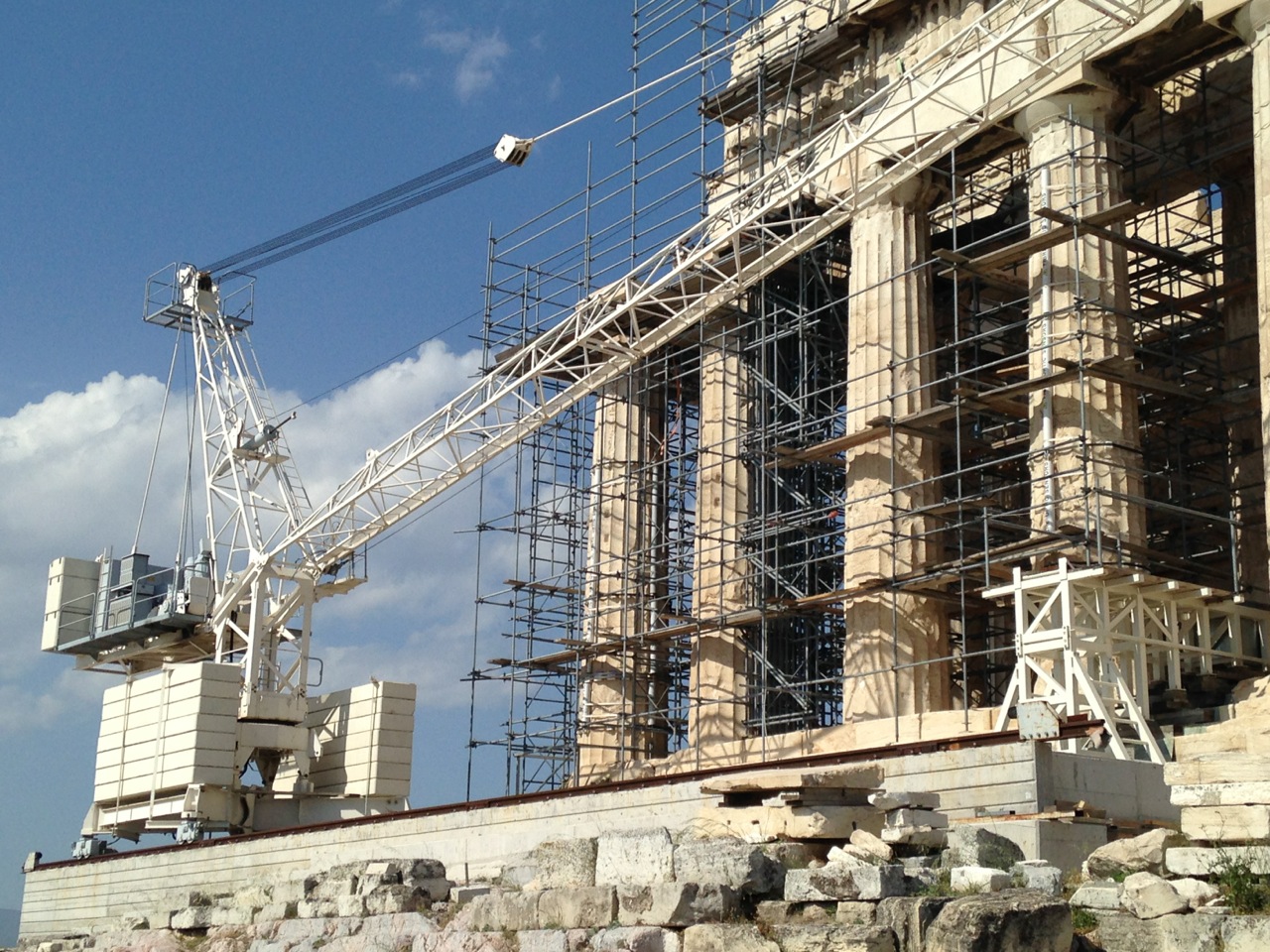
A construction crane and scaffolding used in restoration efforts at the west end of the Parthenon. Expect them to still be here when you arrive. The Greeks have been at this for a couple of decades and expect to spend a couple more shoring up the ruins and occasionally put a shard back in place.
In the present, the Acropolis is motivating people to sustain it. In 1975 the Greek government and international organizations embarked on a modern restoration plan to preserve and rehabilitate. They expect to be at it another 20 years at least. And $200 million was raised to build an expansive new Acropolis museum to house and preserve the most delicate works of art and to spread the fervor that the site inspires.
Truth 7: The Parthenon is airy. The Parthenon was not always airy.
It is the Grand Dame of the Acropolis, and justifiably so. (Okay, Athena is the real Grand Dame of the Acropolis. The Parthenon is her pad.)
Extraordinary, isn’t it? Those majestic columns! The incredible sense of lightness! Such a majestic structure! You can see the sky behind the columns!
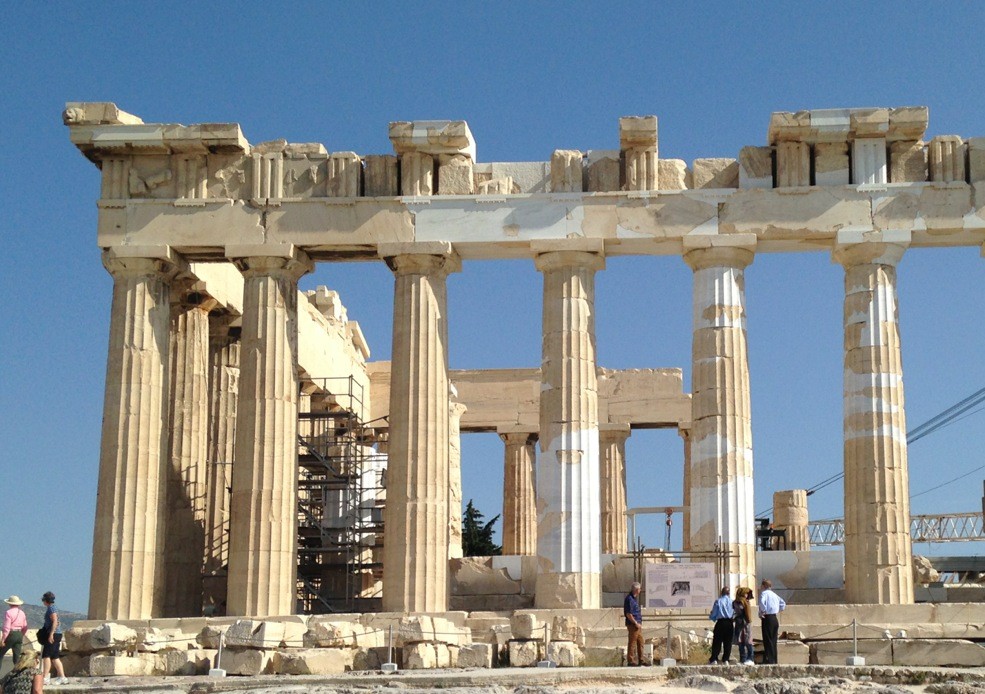
Whether up close or far away, atop the mesa or down in Athens, looking through the ruined columns of the Parthenon at the Grecian sky gives it an additional feeling of lightness.
True. Now.
In my scientific heart, I know clouds don’t have straight lines and don’t rest on the ground. Yet the columnar form combined with white marble and elevation give an effect that is almost cloud-like. Both in the streets of Athens and up on the terrace next to it, the Parthenon feels much lighter and atmospheric than thousands of tons of rock have any right to.
Altitude + Greek Sky + Pentelic Marble = Fluffy Soft Atmosphere.
But being here—viewing the ruins, studying the history, visiting the museums—helps me understand that the original building probably had a different feel.
The original structure had a massive, solid stone building and wooden roof in the middle of it.
Circa 438 BCE, you would have seen a magnificent row of columns on the outside, but they wouldn’t have been framed by the sky. Instead they would have been backdropped by a block of marble. Cooling shadows from under the roof, not the blazing blue sky of Greece.
Explosives were needed to give it the airiness we love so much!
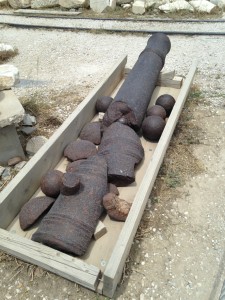
A shattered cannon among the ruins testifies to the Ottoman-Eurpoean conflict that caused the greatest destruction to the Parthenon.
For a couple hundred years the Ottoman Empire ran what is now modern Greece. Being militarily competent and not caring too much about Greek culture, they took the high ground and converted it into a military fortification.
They made the central structure of the Parthenon a gunpowder magazine.
In 1687 the Venetian army came to town to drive out the Ottomans. “Commence firing!” After eight days of bombardment, a direct hit from a Venetian mortar touched off the powder magazine and blew up most of the inner building and a lot of the north and south columns. The fire lasted two days. No roof remained.
From then on, the Parthenon was all air and sky.
Truth 8: The jigsaw puzzle is hypnotizing.
It’s true that people were slowly deconstructing and reconstructing the Acropolis for years. First the Persians. Then the Romans. Then the Christians. Then the Ottomans.
And of course artillery and exploding gunpowder tend to make things a mess.
Don’t forget Lord Elgin stepping in with a team of chiselers and hauling away boatloads to London.
Yet there is still plenty here.
Some standing, some spread around the monument.
The parts spread around the mesa—some neatly catalogued and stacked, some still piled willy-nilly—are absolutely fascinating.
The challenge sucks you in because some parts are obvious. “Oh, that belongs to the outer colonnade of the Parthenon. And that goes with the roof line of the Propylaea.”
And because some of the game is easy, you start looking at the other pieces, now sure that you’re a genius archeologist.
“I wonder where that goes?”
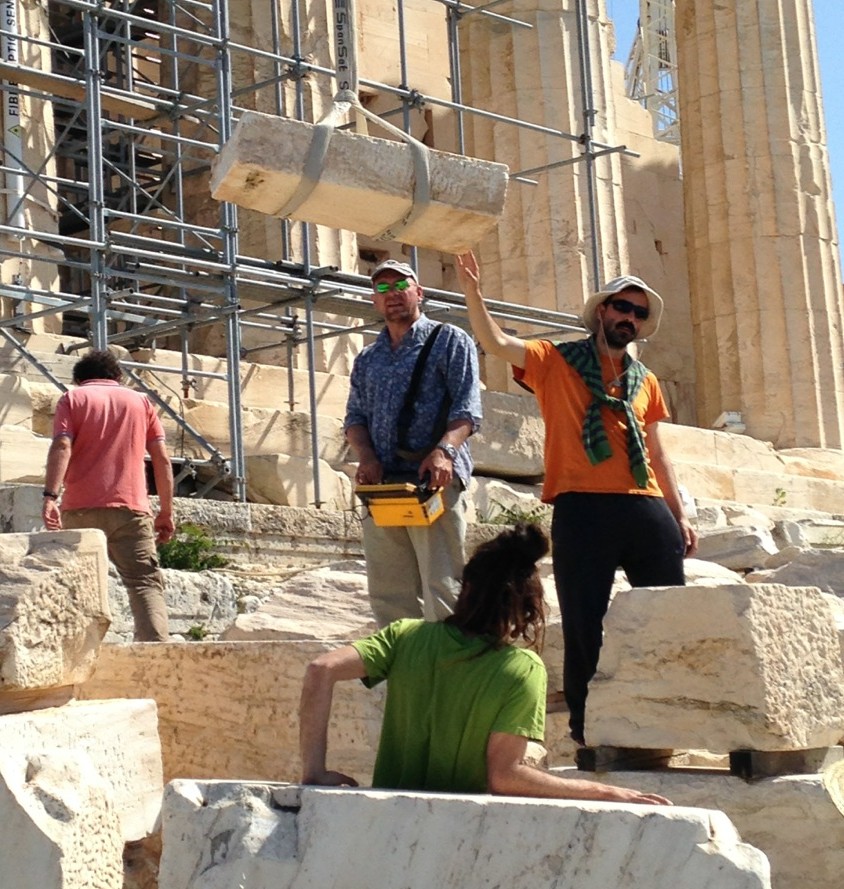
The professional puzzlers working on the Parthenon. Blue-shirt man is controlling a construction crane to reposition the marble fragment in the sling. Jigsaw puzzling at this scale is slow business: they move one or two pieces of stone per day.
And before the afternoon is over you have a much better understanding of why there are career archeologists and that they have a fun and terribly challenging task.
When you come here—and yes, you should come here—I don’t doubt you’ll enjoy the grand, scattered, mortal and ancient genius that it represents.
From all over the mesa,
Chris
Recent Comments